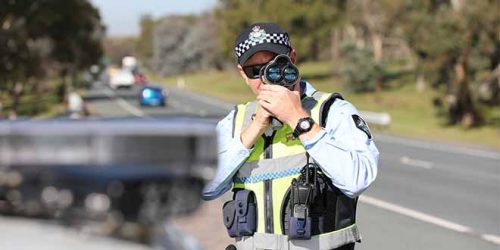
Mobile-detection cameras can see if you’re on the phone, a tablet or smart watches and they’re being tested in Canberra. But how do they work? Reporter LILY PASS has that answer and more…
THE ACT government has begun testing a mobile-device detection camera on the Majura Parkway.
The testing is to ensure the technology works in the ACT road environment, and is an early step towards wider deployment of the cameras throughout Canberra.
The initial testing process on the Parkway could take up to eight weeks, and there is a sign up a few hundred metres before the camera to let people know that it is only a test, and no fines, infringements or warning notices will be issued.
Later in the year as more cameras are rolled out around Canberra, there will be a three-month grace period and a communications campaign to warn drivers, and to help them change their behaviour.
Here, Transport Canberra deputy director-general Ben McHugh gives some insight into Canberra’s new mobile phone detection cameras.

How does it work?
The technology is clever, so it takes a photo of the vehicle and then runs an algorithm over the image to detect whether there’s a possibility of the driver holding or using a device, and then goes through a validation process. There’s a requirement within the technology that all of the faces and images are blurred out, so that the privacy of the operators is maintained.
Why the Majura Parkway?
The testing is just to make sure the technology works on our network, on one of our higher-speed roads, so that is why we chose the Majura Parkway, because it is one of our busier and higher-speed roads.
How far can it detect?
That is subject to the technology that we choose and, at the moment, we’re in a procurement process, so we can’t really disclose that. Generally speaking if you think about it, the camera sits up above the roadway and takes a picture down towards the vehicle and through the front windscreen into the driver’s seat of the car to see if there’s a device in the hand of the driver, so within 20 or 30 metres would be the maximum range that it could actually take that photo. It doesn’t pick you up 300 metres down the road like some other speed-detection devices can, it’s very much subject to being able to take a photo that can detect a device in the hand of a driver, so it has to obviously be relatively close to achieve that.
How accurate is it?
It’s highly accurate, and it’s been tested and acquired in other jurisdictions for a number of years now. In NSW they’ve been using similar pieces of equipment for some time, and obviously they’ve refined the quality of the technology to make it highly accurate.
How many cameras are being tested on the Majura Parkway?
We’re just testing the one at the one location.
How many will be rolled out later this year?
That’s subject to the outcome, but we’re targeting around five. Some may be portable and some may be permanent, but that’s yet to be finalised.
Is it mainly targeting people on their phones?
Tablets, phones and smart watches, devices that would require you to touch or hold them, which is a demonstration of the lack of control of the vehicle.
How will fines work?
The cameras and the technology itself purely identify the image and the car that’s involved in that incident, and the fine goes back through our normal systems, in similar ways to how we would issue infringements and notices associated with speeding cameras.
Fines for:
- Messaging, social networking, accessing apps or the internet will cost $589 and four demerit points.
- Using a handheld device to make or receive calls, $487 and three demerit points.
- Using a mobile device to make or receive calls as an L or P-plate driver, $487 and three demerit points.
How is it set up?
It’s actually mounted to a trailer, it’s on a pole that extends up and out of the trailer and then it swings around and shoots down towards the road, so it does look different to most of the other technology out there like speed camera vans.
So, what is allowed?
Full licence holders can use their mobile device as a navigation tool and to play music and audio if the mobile device is secured in a mounting device affixed to the vehicle or connected through Bluetooth, and the mobile device isn’t being touched or held, which includes having it resting on your body.
Full licence holders can make or receive calls subject to the mobile device being secured in a mounting device or connected via Bluetooth. You can touch your device while it is in a mount to answer and end calls, but for no other reason.
If your mobile device is not secured, you can only answer if you don’t touch your mobile device, such as through voice activation or steering-wheel controls.
Learner and provisional drivers can listen to music and audio, provided the mobile device is not being held by the driver and does not require interaction by any means, including by voice, while driving.
Learner and provisional drivers can use their mobile device for navigation, provided the device is secured in a mounting device affixed to the vehicle, and does not require interaction by any means, including by voice, while driving. Set up GPS instructions before you drive.
Who can be trusted?
In a world of spin and confusion, there’s never been a more important time to support independent journalism in Canberra.
If you trust our work online and want to enforce the power of independent voices, I invite you to make a small contribution.
Every dollar of support is invested back into our journalism to help keep citynews.com.au strong and free.
Thank you,
Ian Meikle, editor





Leave a Reply